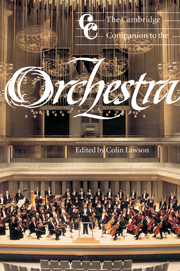Book contents
- Frontmatter
- 1 The history of the orchestra
- 2 The development of musical instruments: national trends and musical implications
- 3 The orchestral repertory
- 4 From notation to sound
- 5 The art of orchestration
- 6 The history of direction and conducting
- 7 International case studies
- 8 The revival of historical instruments
- 9 Recording the orchestra
- 10 Training the orchestral musician
- 11 The life of an orchestral musician
- 12 Historical recordings of orchestras
- 13 The orchestral composer
- 14 Educational programmes
- 15 The future of the orchestra
- Notes
- Appendices
1 - The history of the orchestra
Published online by Cambridge University Press: 28 September 2011
- Frontmatter
- 1 The history of the orchestra
- 2 The development of musical instruments: national trends and musical implications
- 3 The orchestral repertory
- 4 From notation to sound
- 5 The art of orchestration
- 6 The history of direction and conducting
- 7 International case studies
- 8 The revival of historical instruments
- 9 Recording the orchestra
- 10 Training the orchestral musician
- 11 The life of an orchestral musician
- 12 Historical recordings of orchestras
- 13 The orchestral composer
- 14 Educational programmes
- 15 The future of the orchestra
- Notes
- Appendices
Summary
The orchestra before 1800
Any history of the ‘orchestra’ will depend significantly on how the term is defined. One can start from two quite different premises: that an orchestra is a corporation of instrumental musicians; and that an orchestra is a corporate musical instrument. The distinction is, in effect, that of the orchestra as an institution and as a sounding body. The history of the institution is a matter for economic, social and other historians dealing with the musical profession and its broader place in Western (or Westernised) art traditions. The history of the ‘instrument’ is more inherently musical, concerning how composers have been motivated by, and have motivated, changes in the constitution of the orchestra in different genres, forms and styles through the ages. These histories are contiguous – one cannot have the instrument without the body of instrumentalists – and yet not necessarily congruent: corporations of instrumentalists existed long before the orchestra as such came into being. For example, it is a moot point whether one can use the term ‘orchestra’ for a group of ceremonial trumpeters at a medieval court, for a Renaissance string or wind band, or even for the 24 violons du Roi in the Versailles of Louis XIV of France. It is no less moot whether one can speak of orchestration, as distinct from the use of instruments, in the works of Monteverdi, Lully, Bach and Handel or even, perhaps, early Haydn.
- Type
- Chapter
- Information
- The Cambridge Companion to the Orchestra , pp. 1 - 21Publisher: Cambridge University PressPrint publication year: 2003
- 1
- Cited by



